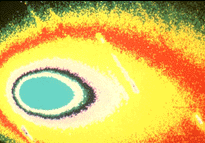

Galaxies at Different Wavelengths
Astronomical objects often look very different when
viewed at different wavelengths of the electromagnetic spectrum. For example,
the primary reason that we perceive spiral galaxies as spirals is that the
spiral arms contain many hot blue and blue-white stars that make these regions
more prominent in the visible spectrum than those regions of the galaxy
that are dominated by older stars whose spectrum is concentrated at longer
wavelengths. Here is an MPEG movie that illustrates this point. It is a
sequence of pictures of the galaxy M81
beginnining at ultraviolet wavelengths and progressing through longer wavelengths
to red light.
As the galaxy "morphs" from its UV image to its red light image, the parts of the galaxy that are visible change considerably. The initial short wavelength images are dominated by young (less than 1 million years old) hot stars in the spiral arms; the final long wavelength images are dominated by old (around 5 billion years) red stars in the core and regions not in the spiral arms.